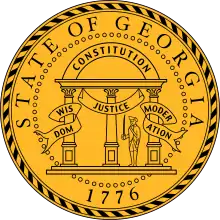List of metropolitan areas in Georgia (U.S. state)
The U.S. Census Bureau lists fourteen metropolitan areas (Metropolitan Statistical Areas) and four trading areas (Combined Statistical Areas) in the U.S. state of Georgia. The tables below include the Census Bureau's most recent population estimate (2019; released April 2020).[1][2]

Atlanta, largest city and metropolitan area

Augusta, second largest metropolitan area
| Rank | Metropolitan Area | Population, est. 2019 |
|---|---|---|
| 1 | Atlanta–Sandy Springs–Roswell | 6,020,364 |
| 2 | Augusta (GA–SC) | 608,980 |
| 3 | Savannah | 393,353 |
| 4 | Columbus (GA–AL) | 321,041 |
| 5 | Macon | 229,996 |
| 6 | Athens | 213,750 |
| 7 | Gainesville | 204,441 |
| 8 | Warner Robins | 185,409 |
| 9 | Valdosta | 147,292 |
| 10 | Albany | 146,726 |
| 11 | Dalton | 144,724 |
| 12 | Brunswick | 118,779 |
| 13 | Rome | 98,498 |
| 14 | Hinesville | 80,994 |
| Rank | Combined Statistical Area | Population, est. 2019 |
|---|---|---|
| 1 | Atlanta–Athens–Clarke County–Sandy Springs (GA-AL) | 6,853,392 |
| 2 | Savannah–Hinesville–Statesboro–Jesup | 583,882 |
| 3 | Columbus–Phenix City (AL)–Auburn (AL)–Opelika (AL) | 485,590 |
| 4 | Macon–Warner Robins | 415,405 |
See also
- Table of United States Metropolitan Statistical Areas
- Table of United States Combined Statistical Areas
- Georgia statistical areas
References
- "Metropolitan and Micropolitan Statistical Areas Population Totals and Components of Change: 2010-2019". United States Census Bureau, Population Division. April 2019. Retrieved April 18, 2020.
- "Metropolitan and Micropolitan Statistical Areas Population Totals and Components of Change: 2010-2019". United States Census Bureau, Population Division. March 26, 2020. Retrieved April 26, 2020.
This article is issued from Wikipedia. The text is licensed under Creative Commons - Attribution - Sharealike. Additional terms may apply for the media files.
